Time-Series MODIS-Based Remote Sensing and Explainable Machine Learning for Assessing Grassland Resilience in Arid Regions
Abstract
1. Introduction
2. Materials and Methods
2.1. Study Area
2.2. Dataset
2.3. Methodology
2.3.1. Data Preprocessing
2.3.2. Random Forest Model for Long-Term TAC
2.3.3. Calculation of Enhanced TAC and Linear Trend (δTAC)
2.3.4. SHAP-Driven Explainability Analysis
3. Results
3.1. Spatiotemporal Patterns of Grassland Resilience
3.1.1. Spatiotemporal Distribution of Long-Term TAC
3.1.2. Spatiotemporal Distribution of Enhanced TAC and δTAC
3.2. Modeling and Interpretation of Long-Term TAC and δTAC
3.2.1. Modeling and Interpretation of Long-Term TAC
3.2.2. Modeling and Interpretation of δTAC
4. Discussion
4.1. A TAC-Based Method for Grassland Resilience Evaluation
4.2. Grassland-Type Differences in Climate and Vegetation Responses
4.3. Model Limitations and Sampling Considerations
4.4. Application Potential for Monitoring and Management
5. Conclusions
Supplementary Materials
Author Contributions
Funding
Data Availability Statement
Acknowledgments
Conflicts of Interest
References
- Poulter, B.; Frank, D.; Ciais, P.; Myneni, R.B.; Andela, N.; Bi, J.; Broquet, G.; Canadell, J.G.; Chevallier, F.; Liu, Y.Y.; et al. Contribution of semi-arid ecosystems to interannual variability of the global carbon cycle. Nature 2014, 509, 600–603. [Google Scholar] [CrossRef]
- Díaz, S.; Zafra-Calvo, N.; Purvis, A.; Verburg, P.H.; Obura, D.; Leadley, P.; Chaplin-Kramer, R.; De Meester, L.; Dulloo, E.; Martín-López, B.; et al. Set ambitious goals for biodiversity and sustainability. Science 2020, 370, 411–413. [Google Scholar] [CrossRef]
- Environment Programme. Intergovernmental Panel on Climate Change Climate Change 2021: The Physical Science Basis. In Proceedings of the Contribution of Working Group I to the Sixth Assessment Report of the Intergovernmental Panel on Climate Change, Cambridge, UK; New York, NY, USA, 9 August 2021; p. 2391. [Google Scholar]
- Du, B.; Zhen, L.; Yan, H.; De Groot, R. Effects of Government Grassland Conservation Policy on Household Livelihoods and Dependence on Local Grasslands: Evidence from Inner Mongolia, China. Sustainability 2016, 8, 1314. [Google Scholar] [CrossRef]
- Lan, X.; Zhang, Q.; Xue, H.; Liang, H.; Wang, B.; Wang, W. Linking sustainable livelihoods with sustainable grassland use and conservation: A case study from rural households in a semi-arid grassland area, China. Land Use Policy 2021, 101, 105186. [Google Scholar] [CrossRef]
- Hou, Q.; Ji, Z.; Yang, H.; Yu, X. Impacts of climate change and human activities on different degraded grassland based on NDVI. Sci. Rep. 2022, 12, 15918. [Google Scholar] [CrossRef] [PubMed]
- United Nations Convention to Combat Desertification Global. Land Outlook: Rangeland Degradation Threatens Food Security and Ecosystem Health; UNCCD: Bonn, Germany, 2022. [Google Scholar]
- Drake, J.E.; Tjoelker, M.G.; Vårhammar, A.; Medlyn, B.E.; Reich, P.B.; Leigh, A.; Pfautsch, S.; Blackman, C.J.; López, R.; Aspinwall, M.J.; et al. Trees tolerate an extreme heatwave via sustained transpirational cooling and increased leaf thermal tolerance. Glob. Change Biol. 2018, 24, 2390–2402. [Google Scholar] [CrossRef] [PubMed]
- Byrne, B.; Liu, J.; Lee, M.; Yin, Y.; Bowman, K.W.; Miyazaki, K.; Norton, A.J.; Joiner, J.; Pollard, D.F.; Griffith, D.W.T.; et al. The Carbon Cycle of Southeast Australia During 2019–2020: Drought, Fires, and Subsequent Recovery. AGU Adv. 2021, 2, e2021AV000469. [Google Scholar] [CrossRef]
- Tao, S.; Wigneron, J.-P.; Chave, J.; Tang, Z.; Wang, Z.; Zhu, J.; Guo, Q.; Liu, Y.Y.; Ciais, P. Little evidence that Amazonian rainforests are approaching a tipping point. Nat. Clim. Change 2023, 13, 1317–1320. [Google Scholar] [CrossRef]
- Su, J.; Zhao, Y.; Xu, F.; Bai, Y. Multiple global changes drive grassland productivity and stability: A meta-analysis. J. Ecol. 2022, 110, 2850–2869. [Google Scholar] [CrossRef]
- Bangira, T.; Mutanga, O.; Sibanda, M.; Dube, T.; Mabhaudhi, T. Remote Sensing Grassland Productivity Attributes: A Systematic Review. Remote Sens. 2023, 15, 2043. [Google Scholar] [CrossRef]
- She, Y.; Li, X.; Zhang, J.; Zhou, H. Effects of soil characteristics on grassland productivity in long-term artificial grassland establishment. Glob. Ecol. Conserv. 2024, 54, e03136. [Google Scholar] [CrossRef]
- Carpenter, S.; Walker, B.; Anderies, J.M.; Abel, N. From metaphor to measurement: Resilience of what to what? Ecosystems 2001, 4, 765–781. [Google Scholar] [CrossRef]
- Scheffer, M.; Bascompte, J.; Brock, W.A.; Brovkin, V.; Carpenter, S.R.; Dakos, V.; Held, H.; van Nes, E.H.; Rietkerk, M.; Sugihara, G. Early-warning signals for critical transitions. Nature 2009, 461, 53–59. [Google Scholar] [CrossRef] [PubMed]
- Suding, K.N.; Gross, K.L.; Houseman, G.R. Alternative states and positive feedbacks in restoration ecology. Trends Ecol. Evol. 2004, 19, 46–53. [Google Scholar] [CrossRef]
- Reynolds, J.F.; Smith, D.M.S.; Lambin, E.F.; Turner, B.L.; Mortimore, M.; Batterbury, S.P.J.; Downing, T.E.; Dowlatabadi, H.; Fernández, R.J.; Herrick, J.E.; et al. Global Desertification: Building a Science for Dryland Development. Science 2007, 316, 847–851. [Google Scholar] [CrossRef] [PubMed]
- Angeler, D.G.; Allen, C.R. Quantifying resilience. J. Appl. Ecol. 2016, 53, 617–624. [Google Scholar] [CrossRef]
- Dakos, V.; Carpenter, S.R.; Brock, W.A.; Ellison, A.M.; Guttal, V.; Ives, A.R.; Kéfi, S.; Livina, V.; Seekell, D.A.; van Nes, E.H.; et al. Methods for Detecting Early Warnings of Critical Transitions in Time Series Illustrated Using Simulated Ecological Data. PLoS ONE 2012, 7, e41010. [Google Scholar] [CrossRef] [PubMed]
- Olden, J.D.; Lawler, J.J.; Poff, N.L. Machine learning methods without tears: A primer for ecologists. Q. Rev. Biol. 2008, 83, 171–193. [Google Scholar] [CrossRef] [PubMed]
- Peters, D.P.C.; Havstad, K.M.; Cushing, J.; Tweedie, C.; Fuentes, O.; Villanueva-Rosales, N. Harnessing the power of big data: Infusing the scientific method with machine learning to transform ecology. Ecosphere 2014, 5, art67. [Google Scholar] [CrossRef]
- Reichstein, M.; Camps-Valls, G.; Stevens, B.; Jung, M.; Denzler, J.; Prabhat, C.N. Deep learning and process understanding for data-driven Earth system science. Nature 2019, 566, 195–204. [Google Scholar] [CrossRef]
- Ribeiro, M.T.; Singh, S.; Guestrin, C. “Why Should I Trust You?”: Explaining the Predictions of Any Classifier. In Proceedings of the 22nd ACM SIGKDD International Conference on Knowledge Discovery and Data Mining, San Francisco, CA, USA, 16 February 2016; pp. 1135–1144. [Google Scholar]
- Lundberg, S.M.; Lee, S.-I. A unified approach to interpreting model predictions. In Proceedings of the 31st International Conference on Neural Information Processing Systems, Long Beach, CA, USA, 4–9 December 2017; pp. 4768–4777. [Google Scholar]
- Lipton, Z.C. The mythos of model interpretability. Commun. ACM 2018, 61, 36–43. [Google Scholar] [CrossRef]
- Lundberg, S.M.; Erion, G.G.; Lee, S.-I.J.A. Consistent Individualized Feature Attribution for Tree Ensembles. arXiv 2018, arXiv:1802.03888. [Google Scholar]
- Cha, Y.; Shin, J.; Go, B.; Lee, D.S.; Kim, Y.; Kim, T.; Park, Y.S. An interpretable machine learning method for supporting ecosystem management: Application to species distribution models of freshwater macroinvertebrates. J. Environ. Manag. 2021, 291, 112719. [Google Scholar] [CrossRef] [PubMed]
- Chen, J.; Wang, S.; Shi, H.; Chen, B.; Wang, J.; Zheng, C.; Zhu, K. Radiation and temperature dominate the spatiotemporal variability in resilience of subtropical evergreen forests in China. Front. For. Glob. Change 2023, 6, 1166481. [Google Scholar] [CrossRef]
- Delaney, J.T.; Larson, D.M. Using explainable machine learning methods to evaluate vulnerability and restoration potential of ecosystem state transitions. Conserv. Biol. 2024, 38, e14203. [Google Scholar] [CrossRef]
- Holling, C.S. Systematics. Resilience and Stability of Ecological Systems. Annu. Rev. Ecol. Syst. 1973, 4, 1–23. [Google Scholar] [CrossRef]
- Pimm, S.L. The complexity and stability of ecosystems. Nature 1984, 307, 321–326. [Google Scholar] [CrossRef]
- Resilience, A. Resilience Alliance: A New Perspective on Ecosystem Management and Sustainability; Resilience Alliance: Stockholm, Sweden, 2002. [Google Scholar]
- Forzieri, G.; Dakos, V.; McDowell, N.G.; Ramdane, A.; Cescatti, A. Emerging signals of declining forest resilience under climate change. Nature 2022, 608, 534–539. [Google Scholar] [CrossRef]
- Smith, T.; Boers, N. Global vegetation resilience linked to water availability and variability. Nat. Commun. 2023, 14, 498. [Google Scholar] [CrossRef] [PubMed]
- Fan, X.; Hao, X.; Hao, H.; Zhang, J.; Li, Y. Comprehensive Assessment Indicator of Ecosystem Resilience in Central Asia. Water 2021, 13, 124. [Google Scholar] [CrossRef]
- Zhang, S.; Yang, Y.; Wu, X.; Li, X.; Shi, F. Postdrought Recovery Time Across Global Terrestrial Ecosystems. J. Geophys. Res. Biogeosci. 2021, 126, e2020JG005699. [Google Scholar] [CrossRef]
- Wu, J.; Sun, Z.; Yao, Y.; Liu, Y. Trends of Grassland Resilience under Climate Change and Human Activities on the Mongolian Plateau. Remote Sens. 2023, 15, 2984. [Google Scholar] [CrossRef]
- Zhang, Y.; Liu, X.; Jiao, W.; Wu, X.; Zeng, X.; Zhao, L.; Wang, L.; Guo, J.; Xing, X.; Hong, Y. Spatial Heterogeneity of Vegetation Resilience Changes to Different Drought Types. Earth’s Future 2023, 11, e2022EF003108. [Google Scholar] [CrossRef]
- Paudel, A.; Chen, Y.-H.; Brodylo, D.; Markwith, S.H. Spatial Monte Carlo Simulation and Analysis of Climate Change Enhanced Fire and Projected Landscape-Scale Variation in Vegetation Heterogeneity. J. Geovis. Spat. Anal. 2024, 8, 22. [Google Scholar] [CrossRef]
- Zhang, S.; Lei, J.; Tong, Y.; Zhang, X.; Lu, D.; Fan, L.; Duan, Z. Temporal and spatial responses of ecological resilience to climate change and human activities in the economic belt on the northern slope of the Tianshan Mountains, China. J. Arid Land 2023, 15, 1245–1268. [Google Scholar] [CrossRef]
- Chen, Y.; Fang, G.; Li, Z.; Zhang, X.; Gao, L.; Elbeltagi, A.; Shaer, H.E.; Duan, W.; Wassif, O.M.A.; Li, Y.; et al. The Crisis in Oases: Research on Ecological Security and Sustainable Development in Arid Regions. Annu. Rev. Environ. Resour. 2024, 49, 1–20. [Google Scholar] [CrossRef]
- He, X.; Zhang, L.; Lu, Y.; Chai, L. Spatiotemporal Variations of Vegetation and Its Response to Climate Change and Human Activities in Arid Areas—A Case Study of the Shule River Basin, Northwestern China. Forests 2024, 15, 1147. [Google Scholar] [CrossRef]
- Yang, J.; Huang, X. The 30 m annual land cover datasets and its dynamics in China from 1985 to 2023. Earth Syst. Sci. Data 2024, 13, 3907–3925. [Google Scholar] [CrossRef]
- Yu, G.; Lu, C.; Xie, G.; Luo, Z.; Yang, L. Grassland ecosystem services and their economic evaluation in qinghai-tibetan plateau based on RS and GIS. In Proceedings of the 2005 IEEE International Geoscience and Remote Sensing Symposium, 2005. IGARSS’05, Seoul, Republic of Korea, 29–29 July 2005; Volume 4, pp. 2961–2964. [Google Scholar]
- Wan, Q.; Meng, Y.; Xie, X.; Zhang, X.; Han, C.; Li, J. An analysis on spatiotemporal differentiation characteristics of the ecosystem service value of the Xinjiang Production and Construction Corps. Shengtai Xuebao Acta Ecol. Sin. 2014, 34, 7057–7066. [Google Scholar] [CrossRef][Green Version]
- China Meteorological Administration. China Ground Climate Data Daily Dataset (SURF_CLI_CHN_MUL_DAY); Version 1.0; China Meteorological Administration: Beijing, China, 2014. Available online: http://data.cma.cn/ (accessed on 11 August 2024).
- China Meteorological Administration. China Ground Climate Data Daily Dataset (SURF_CLI_CHN_MUL_DAY); Version 3.0; China Meteorological Administration: Beijing, China, 2019. Available online: http://data.cma.cn/ (accessed on 11 August 2024).
- Hersbach, H.; Bell, B.; Berrisford, P.; Biavati, G.; Horányi, A.; Muñoz Sabater, J.; Nicolas, J.; Peubey, C.; Radu, R.; Rozum, I.; et al. ERA5 hourly data on single levels from 1940 to present. Copernicus Climate Change Service (C3S) Climate Data Store (CDS), 2023. Available online: https://cds.climate.copernicus.eu (accessed on 3 September 2024).
- Didan, K. MOD13A2 MODIS/Terra Vegetation Indices 16-Day L3 Global 1km SIN Grid V006. Available online: https://www.earthdata.nasa.gov/data/catalog/lpcloud-mod13a2-006 (accessed on 6 August 2024).
- Gao, J.; Shi, Y.; Zhang, H.; Chen, X.; Zhang, W.; Shen, W.; Xiao, T.; Zhang, Y. China Regional 250 m Fractional Vegetation Cover Dataset (2000–2023). National Tibetan Plateau Data Center, 2024. Available online: https://data.tpdc.ac.cn (accessed on 19 October 2024).
- Tang, J.; Xu, X.; Zhang, A.; Zhang, N. Spatial and Temporal Variation of Temperate Grassland Types in Eurasia—China Regional Three-Level Classification (1980s). National Tibetan Plateau Data Center, 2020. Available online: https://data.tpdc.ac.cn/zh-hans/data/20722773-9955-4d6e-a761-ed23814aca41 (accessed on 14 December 2024).
- Saeed, W.; Omlin, C. Explainable AI (XAI): A systematic meta-survey of current challenges and future opportunities. Knowl. Based Syst. 2023, 263, 110273. [Google Scholar] [CrossRef]
- Berdugo, M.; Delgado-Baquerizo, M.; Soliveres, S.; Hernández-Clemente, R.; Zhao, Y.; Gaitán, J.J.; Gross, N.; Saiz, H.; Maire, V.; Lehmann, A.; et al. Global ecosystem thresholds driven by aridity. Science 2020, 367, 787–790. [Google Scholar] [CrossRef]
- Scheffer, M.; Carpenter, S.; Foley, J.A.; Folke, C.; Walker, B. Catastrophic shifts in ecosystems. Nature 2001, 413, 591–596. [Google Scholar] [CrossRef]
- Mayer, A.L.; Rietkerk, M. The Dynamic Regime Concept for Ecosystem Management and Restoration. BioScience 2004, 54, 1013–1020. [Google Scholar] [CrossRef]
- Stevens-Rumann, C.S.; Kemp, K.B.; Higuera, P.E.; Harvey, B.J.; Rother, M.T.; Donato, D.C.; Morgan, P.; Veblen, T.T. Evidence for declining forest resilience to wildfires under climate change. Ecol. Lett. 2018, 21, 243–252. [Google Scholar] [CrossRef]
- Li, J.; He, B.; Ahmad, S.; Mao, W. Leveraging explainable machine learning models to assess forest health: A case study in Hainan, China. Ecol. Evol. 2023, 13, e10558. [Google Scholar] [CrossRef]
- Boulton, C.A.; Lenton, T.M.; Boers, N. Pronounced loss of Amazon rainforest resilience since the early 2000s. Nat. Clim. Change 2022, 12, 271–278. [Google Scholar] [CrossRef]
- Kéfi, S.; Guttal, V.; Brock, W.A.; Carpenter, S.R.; Ellison, A.M.; Livina, V.N.; Seekell, D.A.; Scheffer, M.; van Nes, E.H.; Dakos, V. Early Warning Signals of Ecological Transitions: Methods for Spatial Patterns. PLoS ONE 2014, 9, e92097. [Google Scholar] [CrossRef]
- Hughes, T.P.; Kerry, J.T.; Connolly, S.R.; Baird, A.H.; Eakin, C.M.; Heron, S.F.; Hoey, A.S.; Hoogenboom, M.O.; Jacobson, M.; Liu, G.; et al. Ecological memory modifies the cumulative impact of recurrent climate extremes. Nat. Clim. Change 2019, 9, 40–43. [Google Scholar] [CrossRef]
- Xu, C.; Ke, Y.; Zhou, W.; Luo, W.; Ma, W.; Song, L.; Smith, M.D.; Hoover, D.L.; Wilcox, K.R.; Fu, W.; et al. Resistance and resilience of a semi-arid grassland to multi-year extreme drought. Ecol. Indic. 2021, 131, 108139. [Google Scholar] [CrossRef]
- Yao, Y.; Liu, Y.; Fu, F.; Song, J.; Wang, Y.; Han, Y.; Wu, T.; Fu, B. Declined terrestrial ecosystem resilience. Glob. Change Biol. 2024, 30, e17291. [Google Scholar] [CrossRef]
- Liu, L.; Gou, X.; Wang, X.; Yang, M.; Qie, L.; Pang, G.; Wei, S.; Zhang, F.; Li, Y.; Wang, Q.; et al. Relationship between extreme climate and vegetation in arid and semi-arid mountains in China: A case study of the Qilian Mountains. Agric. For. Meteorol. 2024, 348, 109938. [Google Scholar] [CrossRef]
- Wei, M.; Jiao, L.; Zhang, P.; Xue, R.; Wang, X.; Li, Q.; Jin, M. Spatial and temporal characteristics of vegetation resilience to drought in China. Sci. China Earth Sci. 2025, 68, 2310–2327. [Google Scholar] [CrossRef]
- Hossain, M.L.; Li, J.; Lai, Y.; Beierkuhnlein, C. Long-term evidence of differential resistance and resilience of grassland ecosystems to extreme climate events. Environ. Monit. Assess. 2023, 195, 734. [Google Scholar] [CrossRef] [PubMed]
- Wang, C.; Vera-Vélez, R.; Lamb, E.G.; Wu, J.; Ren, F. Global pattern and associated drivers of grassland productivity sensitivity to precipitation change. Sci. Total Environ. 2022, 806, 151224. [Google Scholar] [CrossRef]
- Cao, W.; Bai, J.; Yu, L. Grassland-type ecosystem stability in China differs under the influence of drought and wet events. J. Arid. Land 2024, 16, 615–631. [Google Scholar] [CrossRef]
- Wang, Y.; Klaus, V.H.; Gilgen, A.K.; Buchmann, N. Temperate grasslands under climate extremes: Effects of plant diversity on ecosystem services. Agric. Ecosyst. Environ. 2025, 379, 109372. [Google Scholar] [CrossRef]
- Shen, M.; Tang, Y.; Chen, J.; Zhu, X.; Zheng, Y. Influences of temperature and precipitation before the growing season on spring phenology in grasslands of the central and eastern Qinghai-Tibetan Plateau. Agric. For. Meteorol. 2011, 151, 1711–1722. [Google Scholar] [CrossRef]
- Duan, H.; Xue, X.; Wang, T.; Kang, W.; Liao, J.; Liu, S. Spatial and Temporal Differences in Alpine Meadow, Alpine Steppe and All Vegetation of the Qinghai-Tibetan Plateau and Their Responses to Climate Change. Remote Sens. 2021, 13, 669. [Google Scholar] [CrossRef]
- Li, Y.; Gong, J.; Zhang, Y.; Gao, B. NDVI-Based Greening of Alpine Steppe and Its Relationships with Climatic Change and Grazing Intensity in the Southwestern Tibetan Plateau. Land 2022, 11, 975. [Google Scholar] [CrossRef]
- Liu, R. Grassland Resilience Assessment Using Explainable Machine Learning in Arid Ecosystems of Northwest China (2001–2023). Figshare. Dataset. 2025. Available online: https://figshare.com/articles/dataset/Grassland_Resilience_Assessment_Using_Explainable_Machine_Learning_in_Arid_Ecosystems_of_Northwest_China_2001_2023_/28804409/2 (accessed on 5 August 2025).
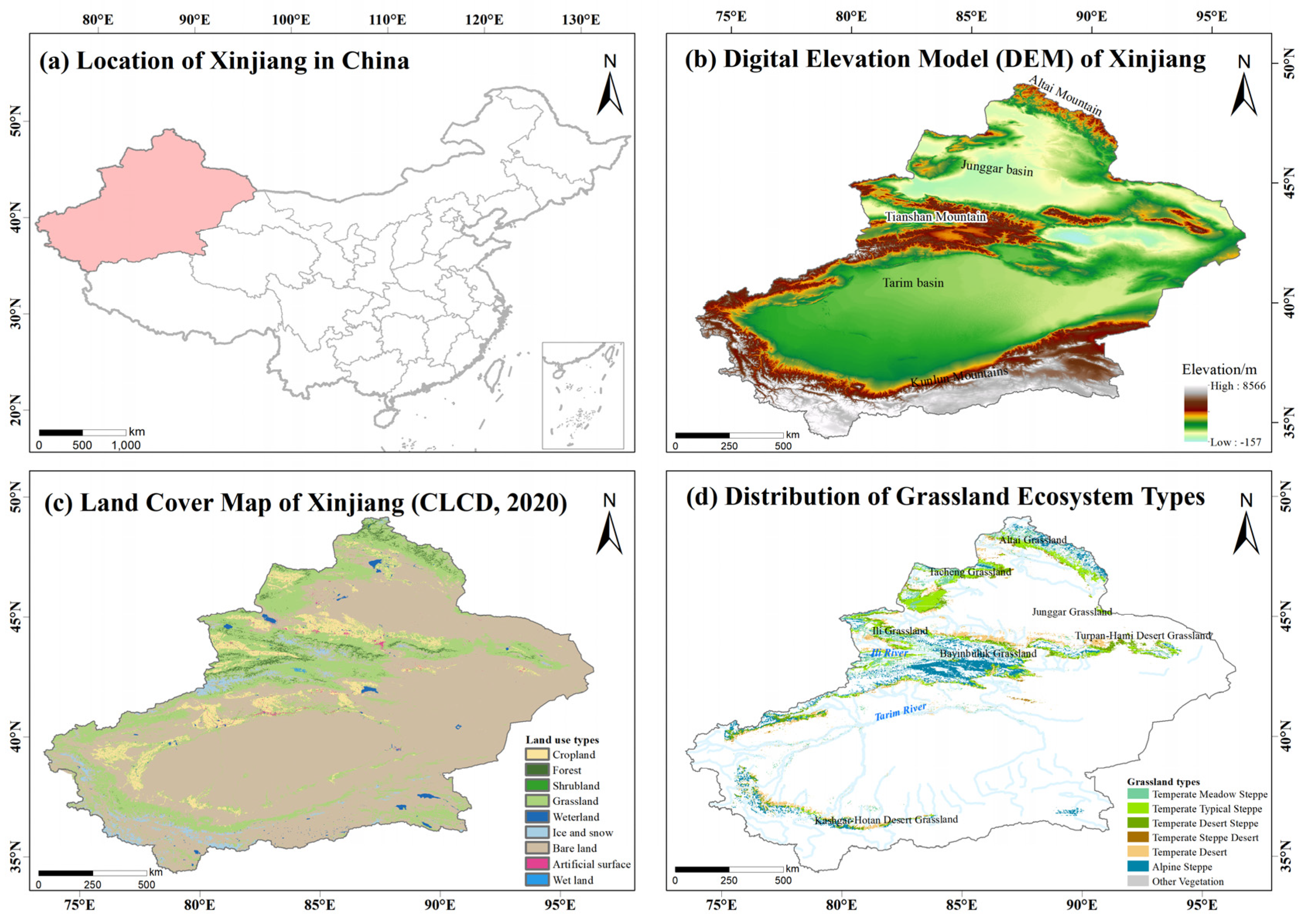
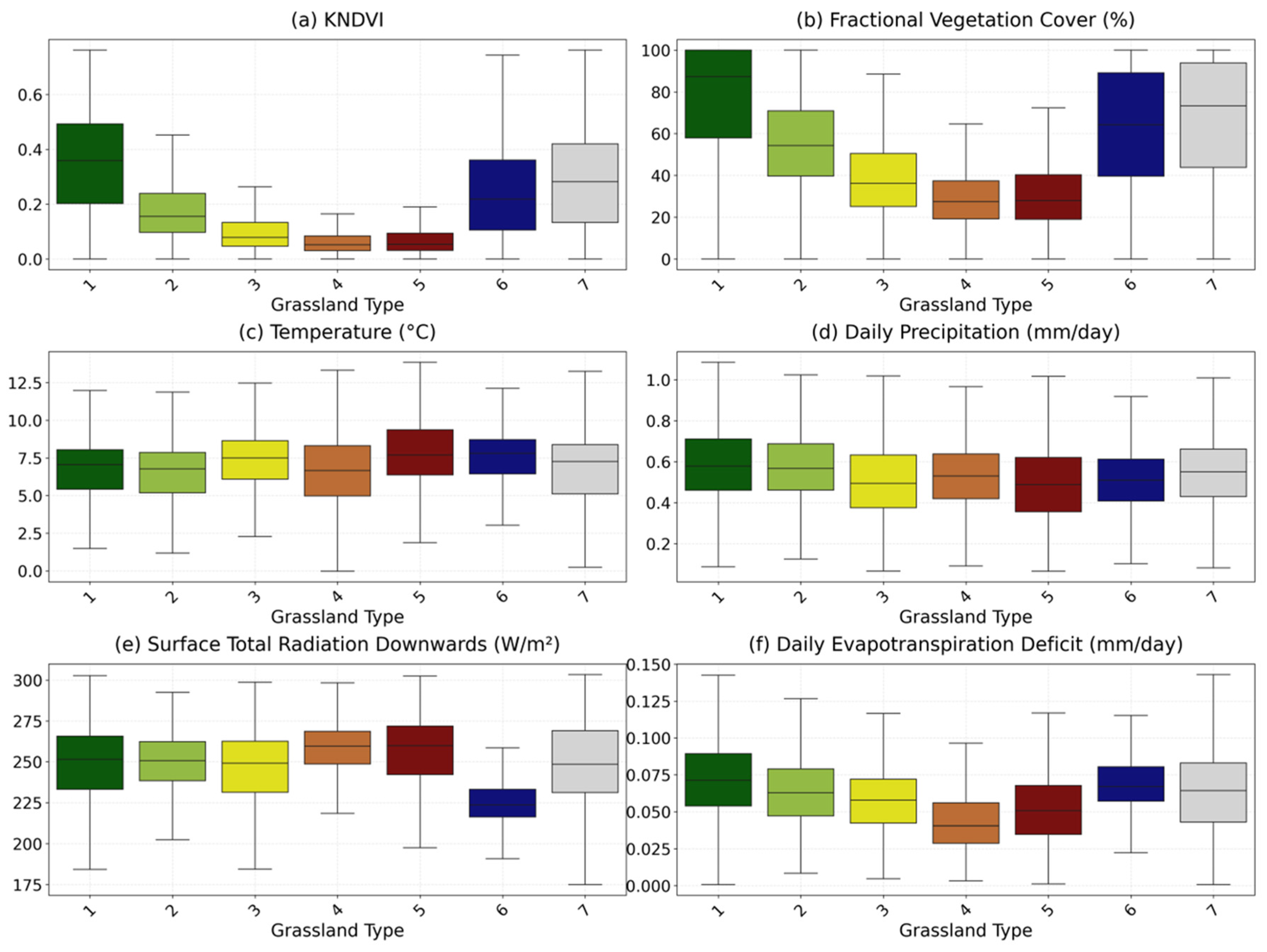
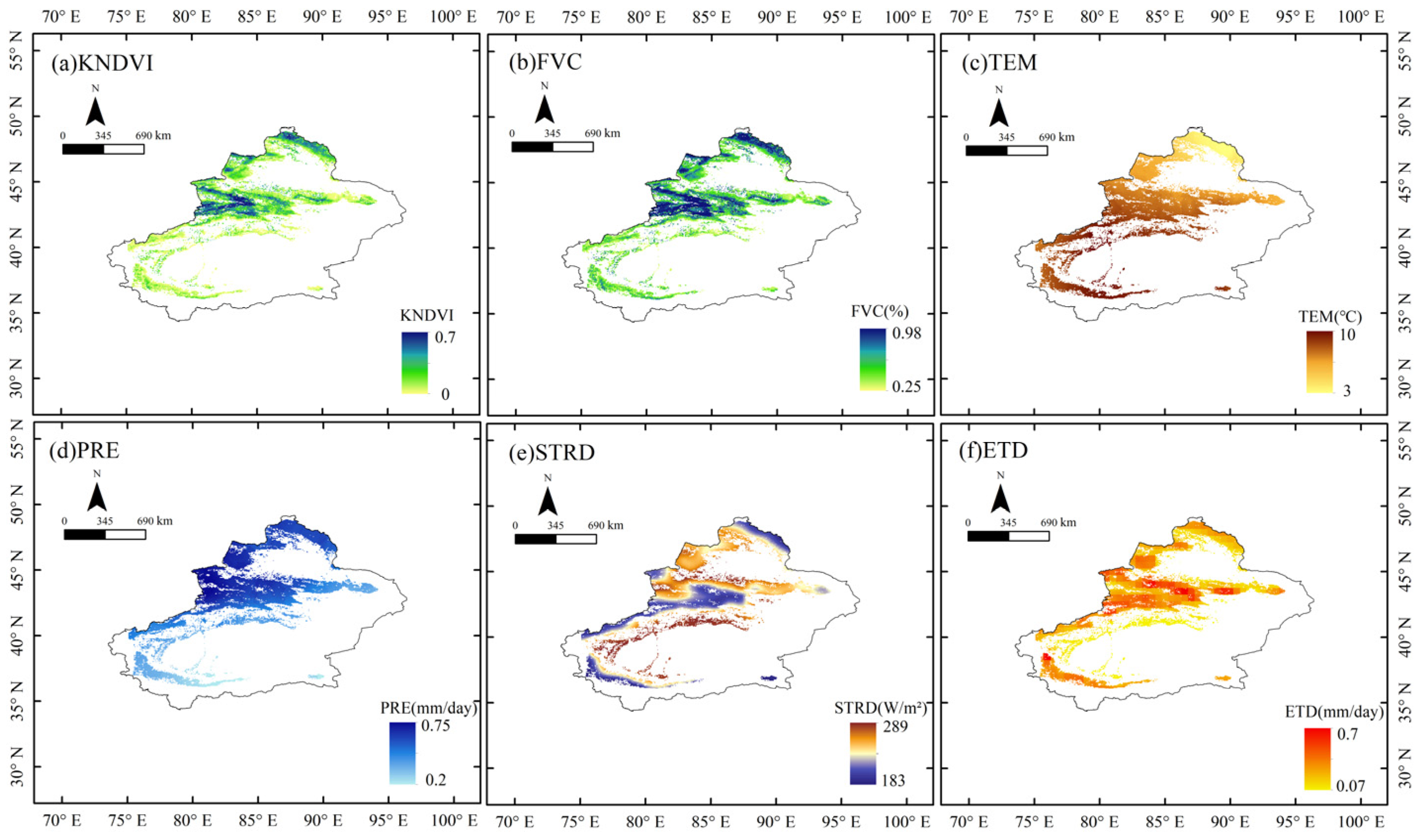
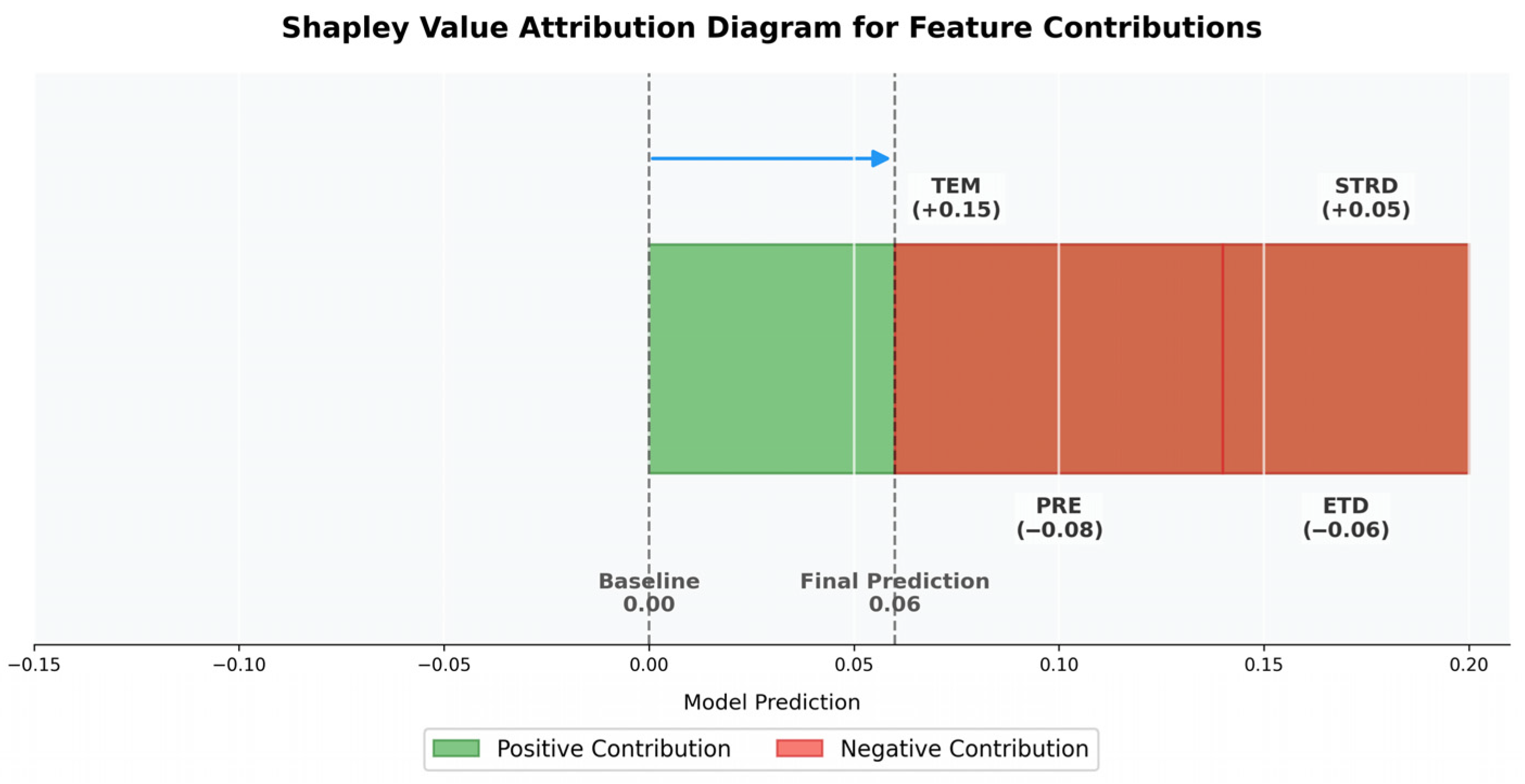
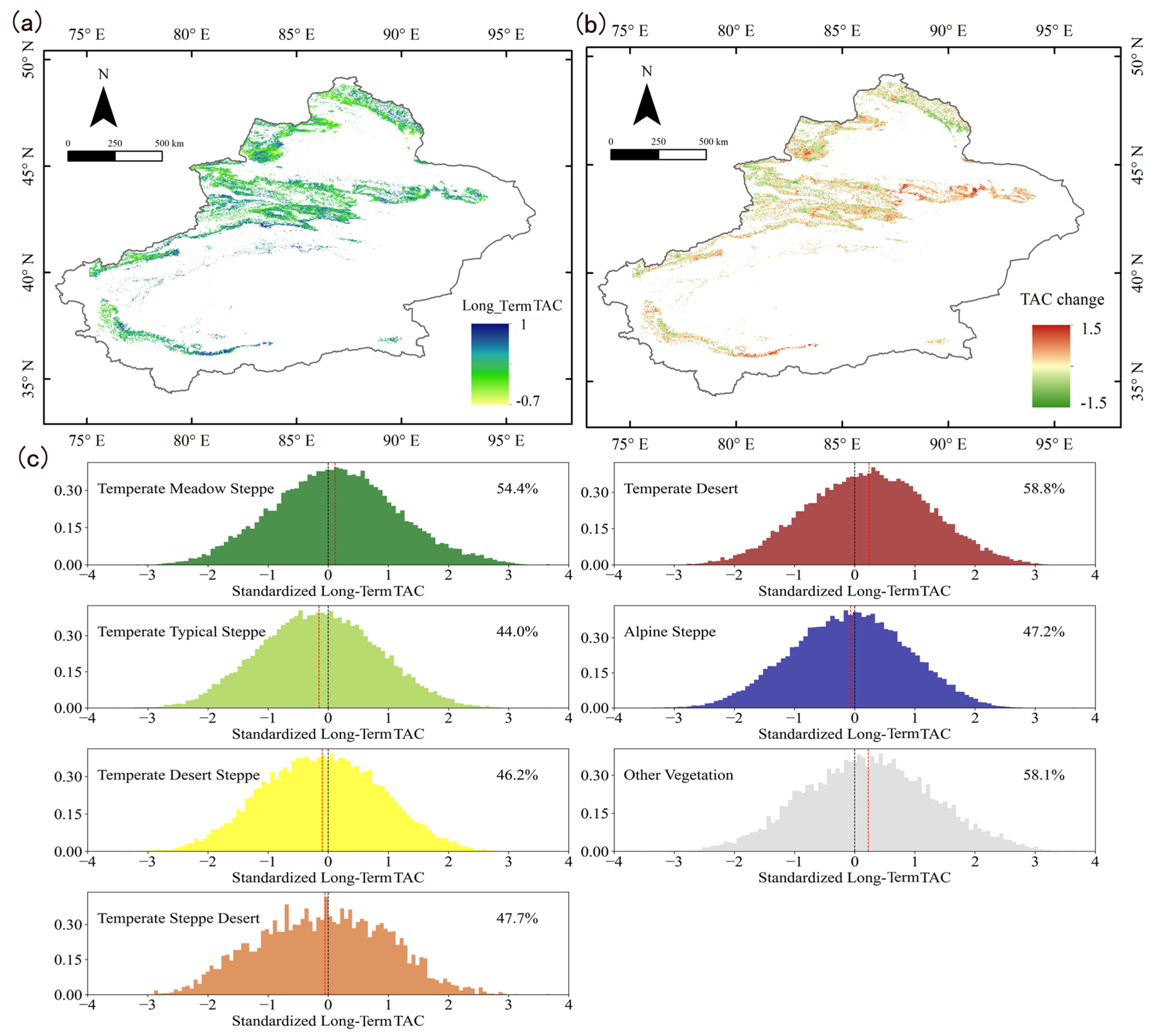
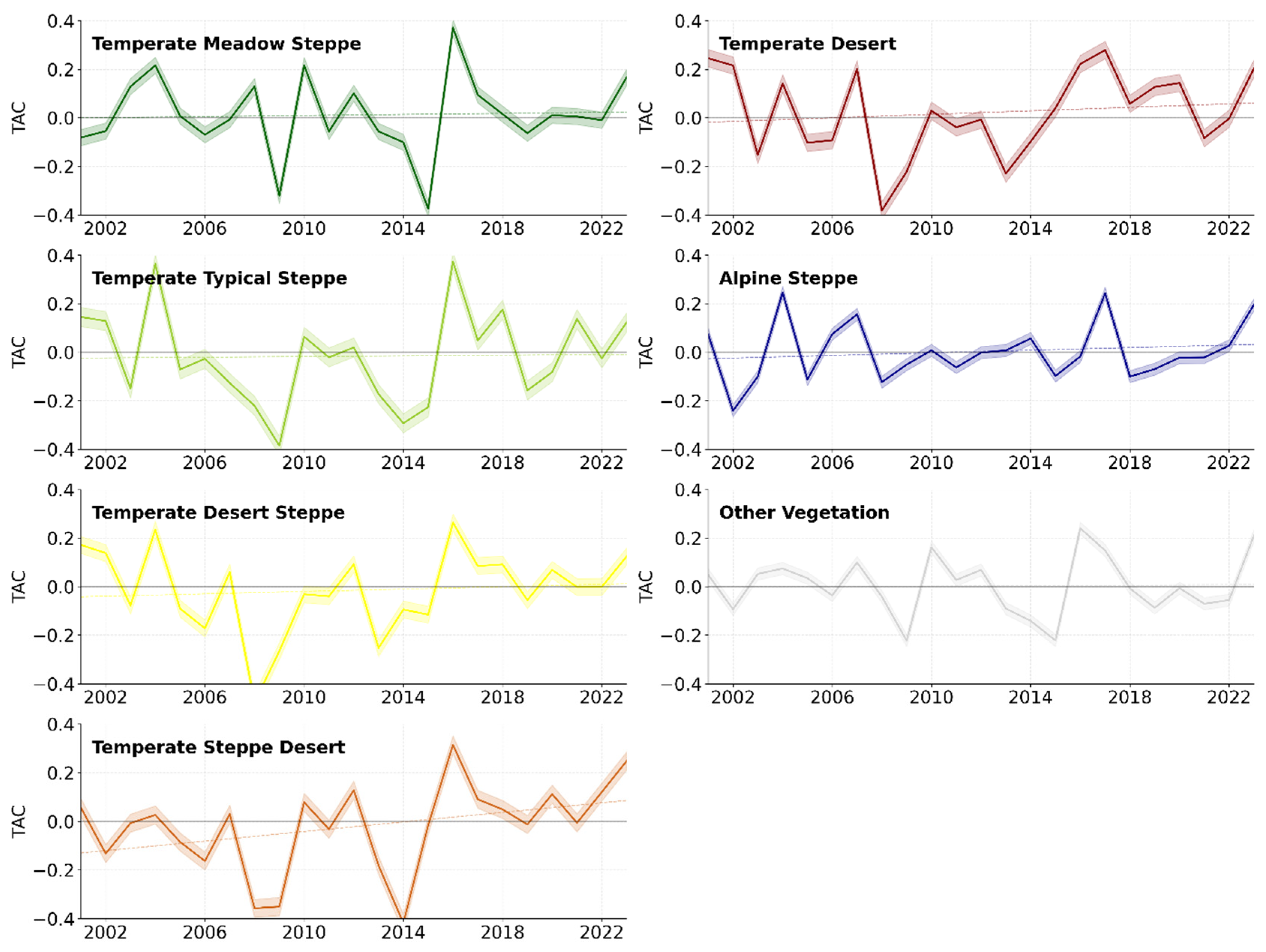
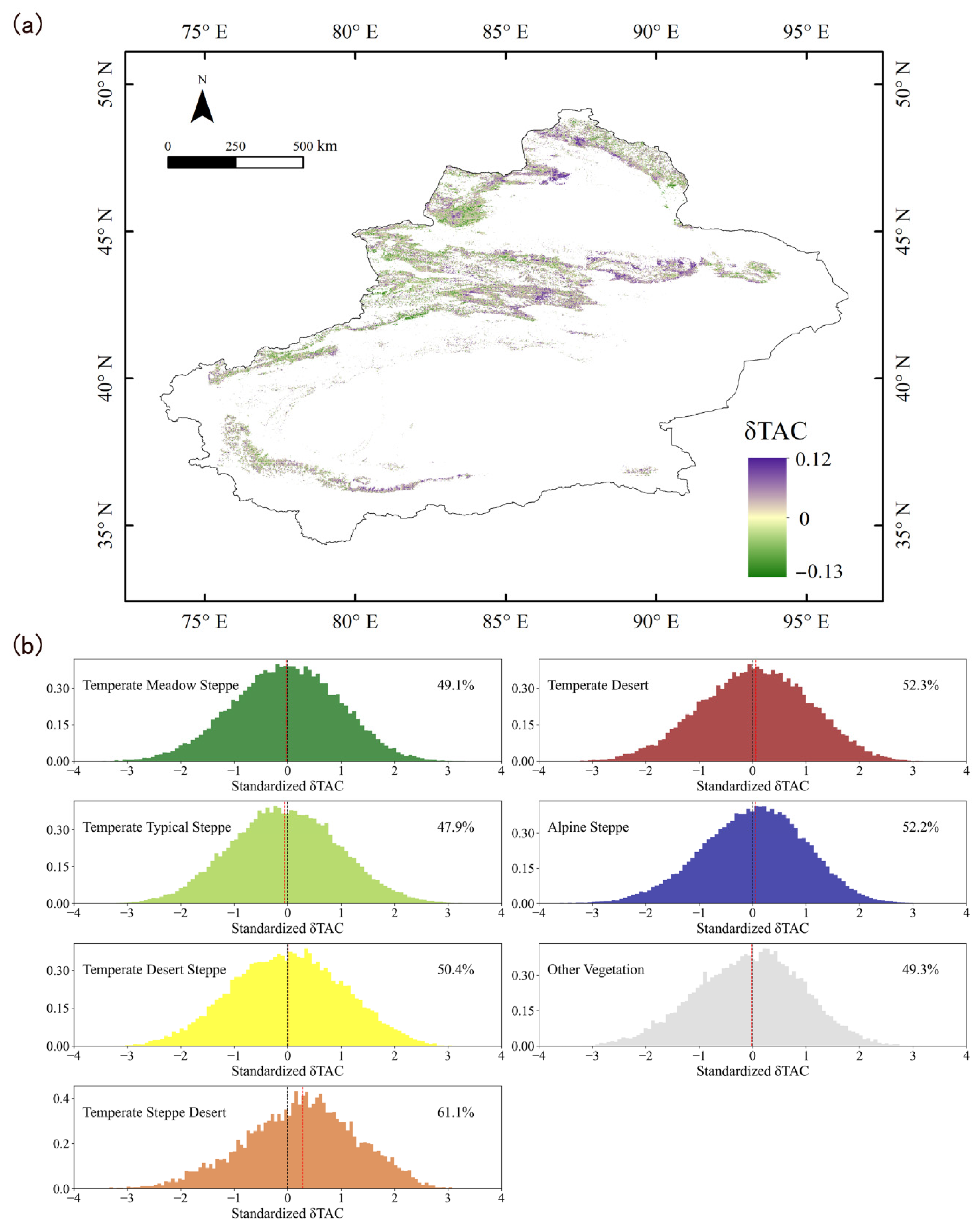
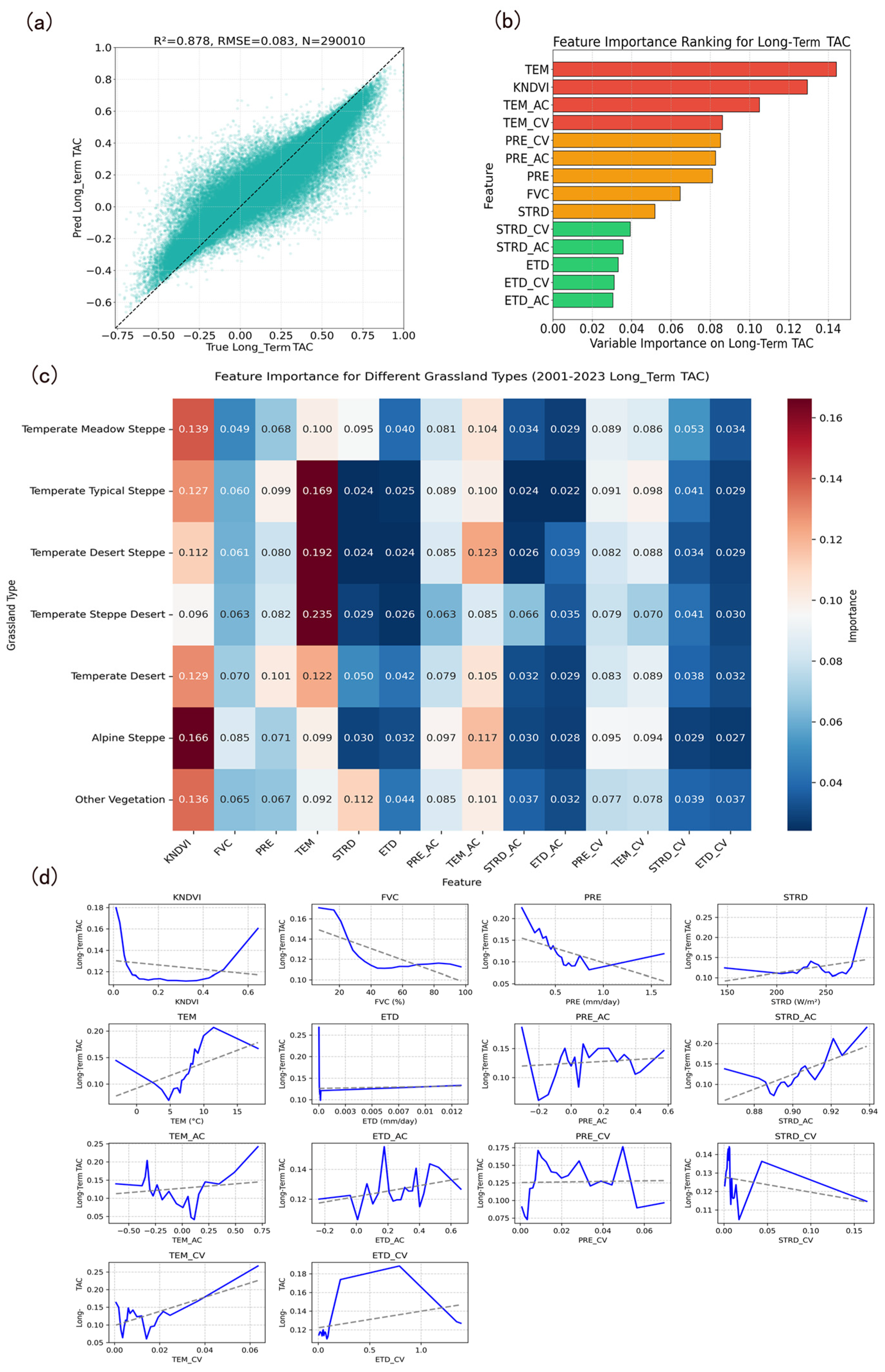
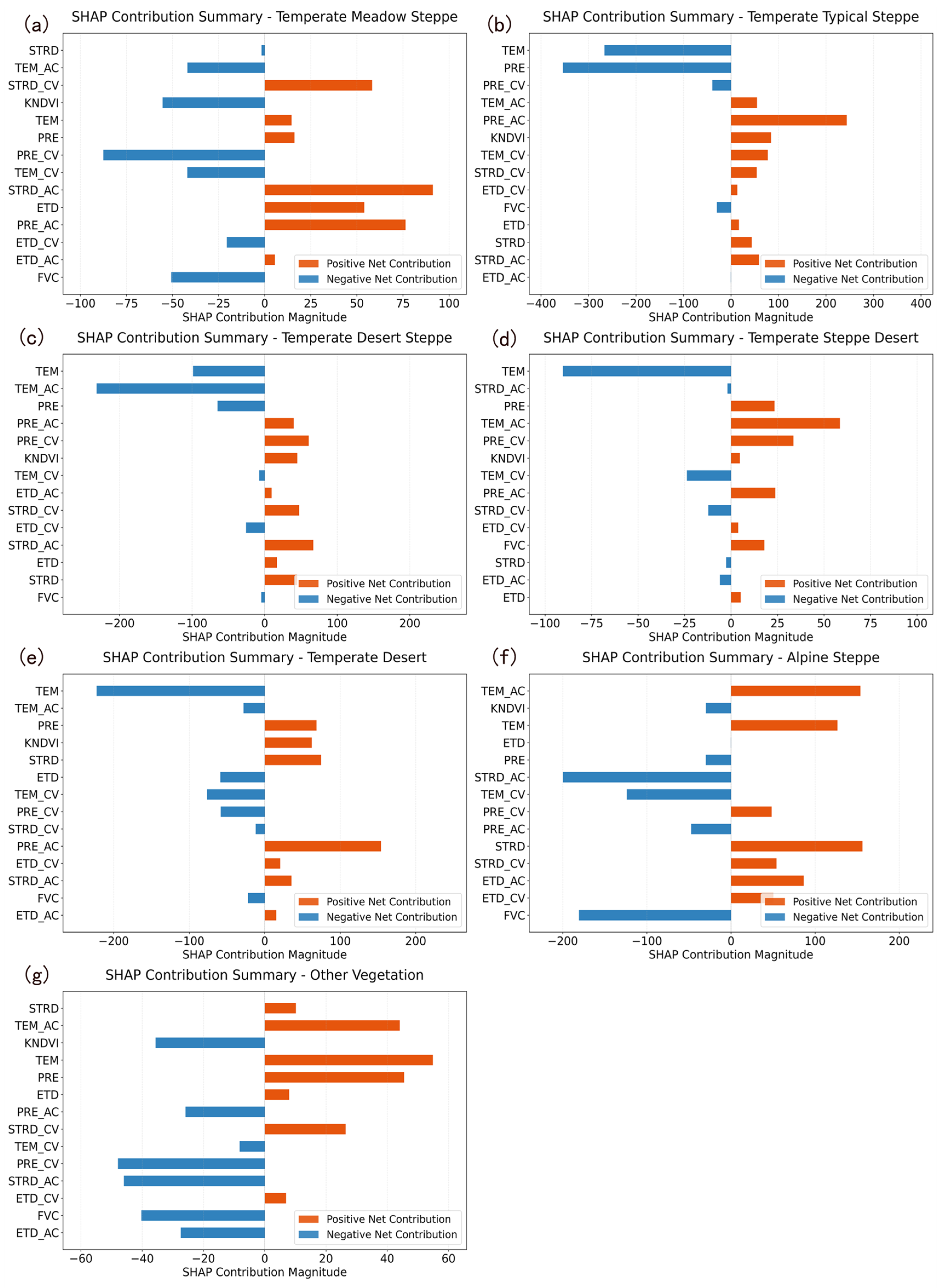
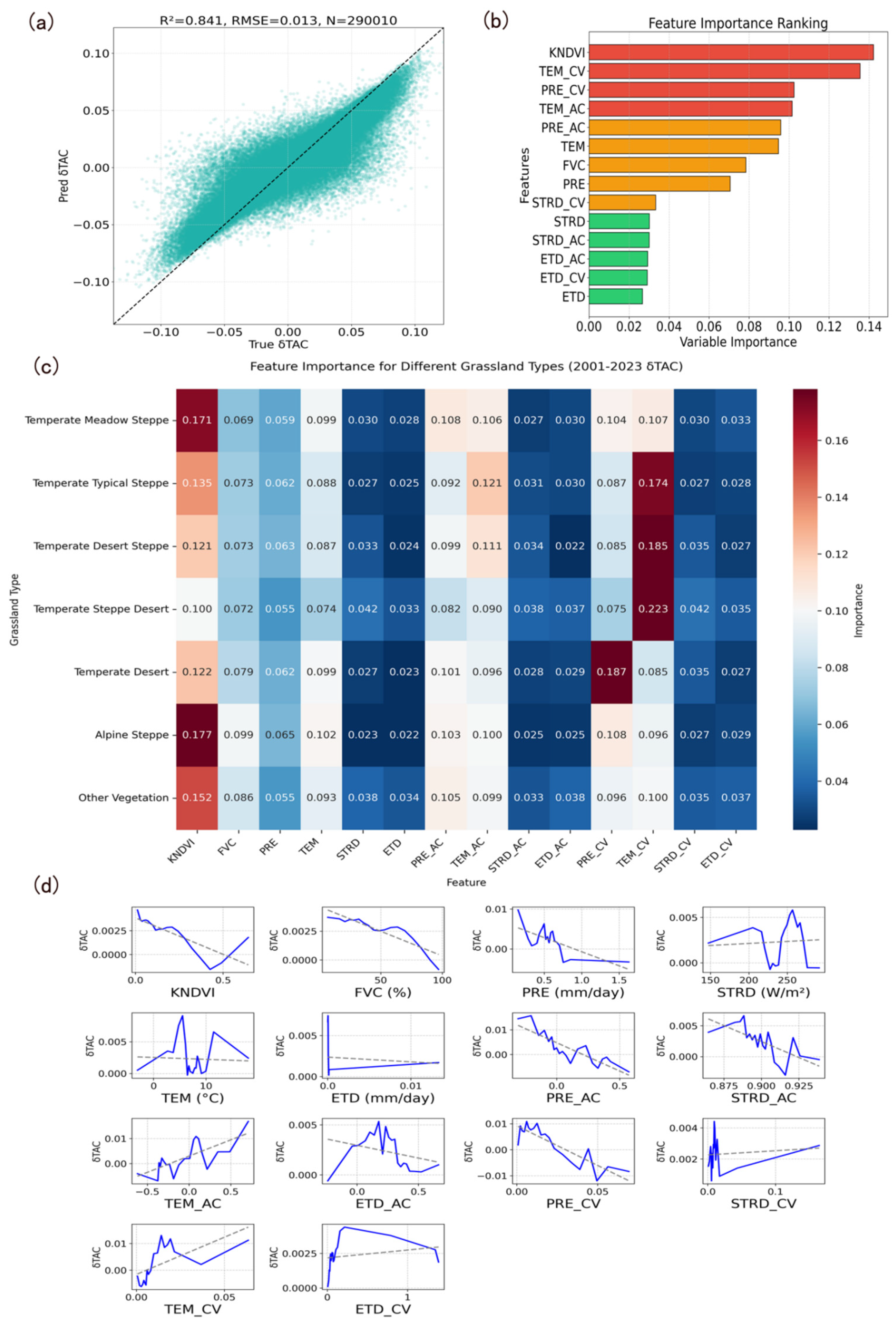
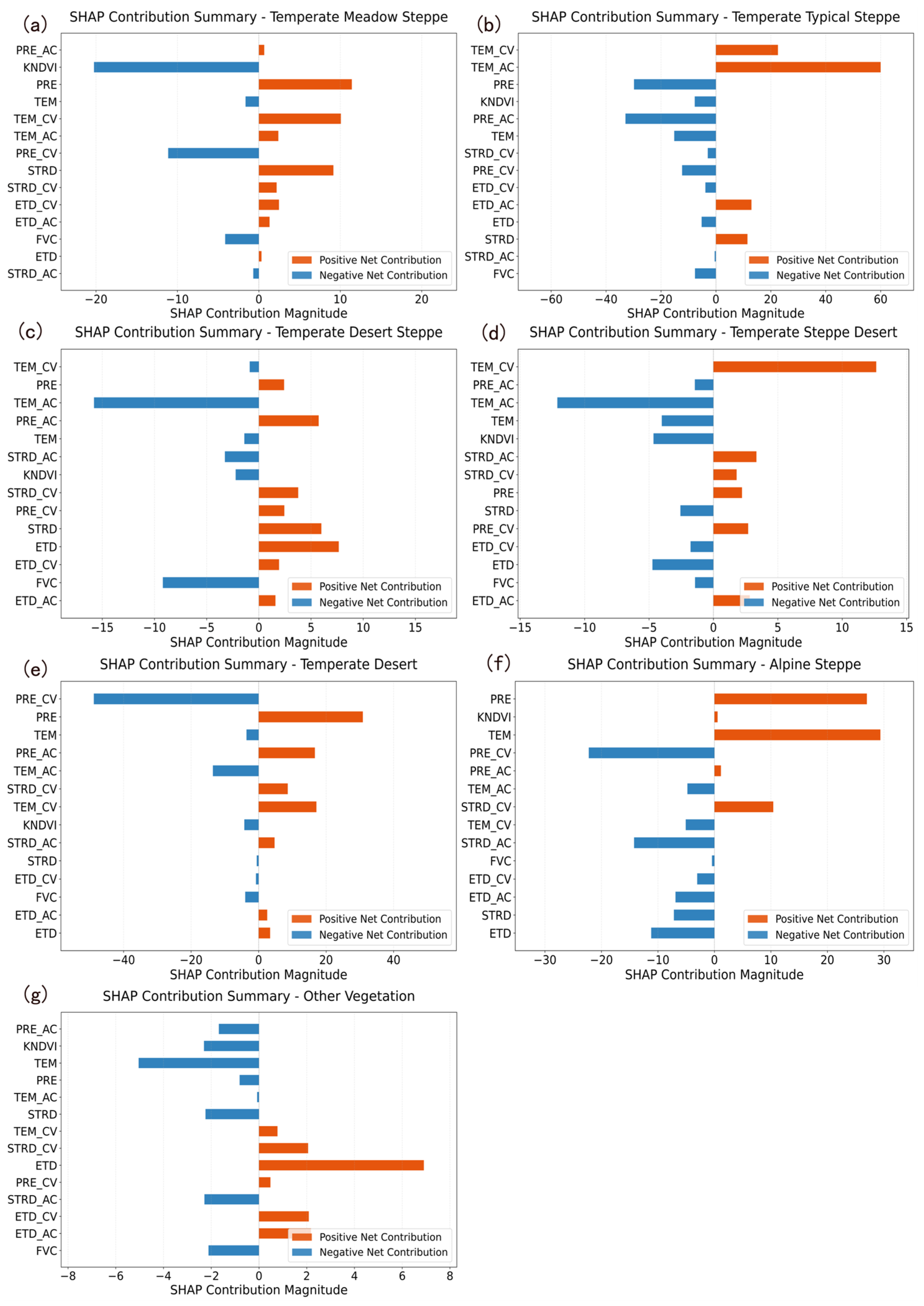
| Data Type | Time Range | Spatial Resolution | Data Source |
|---|---|---|---|
| Meteorological Data (Precipitation, Temperature) | 2001–2019 | Point (station-based) | China Surface Climate Daily Dataset (V3.0) (SURF_CLI_CHN_MUL_DAY) |
| Surface Total Radiation Downward (STRD) | 2001–2023 | ~0.25° (~25 km) | ERA5 Reanalysis Dataset |
| Evapotranspiration (ET) | 2001–2023 | ~0.25° (~25 km) | ERA5 Reanalysis Dataset |
| Normalized Difference Vegetation Index (NDVI) | 2001–2023 | 1 km | MODIS MOD13A2 Product |
| Fractional Vegetation Cover (FVC) | 2000–2023 | 250 m | National Tibetan Plateau Scientific Data Center (250 m NDVI Product) |
| Land Use Data | 2000–2023 | 30 m | Wuhan University State Key Laboratory of Surveying and Mapping Remote Sensing Information Engineering |
| Grassland Type Classification | 2020 | 1 km | Temporal and Spatial Variability of Temperate Grassland Types in Eurasia |
| Variable Name | Category | Label |
|---|---|---|
| Average KNDVI | Vegetation Attributes | KNDVI |
| Average FVC | Vegetation Attributes | FVC |
| Average Total Precipitation (PRE) | Climate Background | PRE |
| Average Surface Total Radiation Downwards (STRD) | Climate Background | STRD |
| Average Air Temperature (TEM) | Climate Background | TEM |
| Average Evapotranspiration Deficit (ETD) | Climate Background | ETD |
| Temporal Autocorrelation of Precipitation | Climate Autocorrelation | PRE _ AC |
| Temporal Autocorrelation of Surface Total Radiation Downward | Climate Autocorrelation | STRD_AC |
| Temporal Autocorrelation of Air Temperature | Climate Autocorrelation | TEM_AC |
| Temporal Autocorrelation of Evapotranspiration | Climate Autocorrelation | ETD_AC |
| Variable Coefficient of Precipitation | Climate Variability | PRE_CV |
| Variable Coefficient of Surface Total Radiation Downward | Climate Variability | STRD_CV |
| Variable Coefficient of Air Temperature | Climate Variability | TEM_CV |
| Variable Coefficient of Evapotranspiration Deficit | Climate Variability | ETD_CV |
Disclaimer/Publisher’s Note: The statements, opinions and data contained in all publications are solely those of the individual author(s) and contributor(s) and not of MDPI and/or the editor(s). MDPI and/or the editor(s) disclaim responsibility for any injury to people or property resulting from any ideas, methods, instructions or products referred to in the content. |
© 2025 by the authors. Licensee MDPI, Basel, Switzerland. This article is an open access article distributed under the terms and conditions of the Creative Commons Attribution (CC BY) license (https://creativecommons.org/licenses/by/4.0/).
Share and Cite
Liu, R.; Yu, Y.; Malik, I.; Wistuba, M.; Guo, Z.; Lu, Y.; Ding, X.; He, J.; Sun, L.; Li, C.; et al. Time-Series MODIS-Based Remote Sensing and Explainable Machine Learning for Assessing Grassland Resilience in Arid Regions. Remote Sens. 2025, 17, 2749. https://doi.org/10.3390/rs17162749
Liu R, Yu Y, Malik I, Wistuba M, Guo Z, Lu Y, Ding X, He J, Sun L, Li C, et al. Time-Series MODIS-Based Remote Sensing and Explainable Machine Learning for Assessing Grassland Resilience in Arid Regions. Remote Sensing. 2025; 17(16):2749. https://doi.org/10.3390/rs17162749
Chicago/Turabian StyleLiu, Ruihan, Yang Yu, Ireneusz Malik, Malgorzata Wistuba, Zengkun Guo, Yuanbo Lu, Xiaoyun Ding, Jing He, Lingxiao Sun, Chunlan Li, and et al. 2025. "Time-Series MODIS-Based Remote Sensing and Explainable Machine Learning for Assessing Grassland Resilience in Arid Regions" Remote Sensing 17, no. 16: 2749. https://doi.org/10.3390/rs17162749
APA StyleLiu, R., Yu, Y., Malik, I., Wistuba, M., Guo, Z., Lu, Y., Ding, X., He, J., Sun, L., Li, C., & Yu, R. (2025). Time-Series MODIS-Based Remote Sensing and Explainable Machine Learning for Assessing Grassland Resilience in Arid Regions. Remote Sensing, 17(16), 2749. https://doi.org/10.3390/rs17162749








